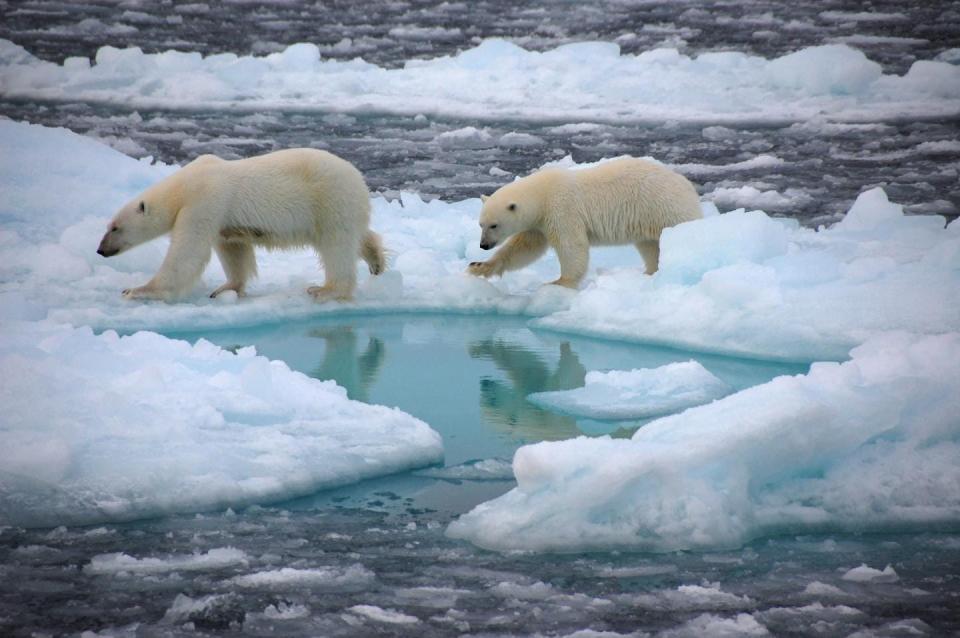Where do polar bears live? Get to know more on the Arctic habitat of the 'sea bear.'
You may have found yourself randomly wondering aboutUrsus maritimus, Latin for "sea bear," more commonly known as polar bears. The furry mammals are stellar swimmers and can be found in the cold oceans of the far north.
But where do polar bears live? And what are the lives of these majestic mammals like?
Here at Just Curious, we've taken the time to give you the rundown on everything you don't know, but might want to know, about polar bear habitats, eating habits and more.
Where do polar bears live?
Most polar bears live in the Arctic. More specifically, they live north of the Arctic Circle to the North Pole.
But, according to the National Wildlife Federation,they can also be found south of the Arctic Circle in Canada's Hudson Bay and James Bay, and in Alaska, Russia, Greenland, and some northern islands owned by Norway, including Svalbard. The World Wildlife Fund reports that 60% of polar bear subpopulations live in Canada.
Polar bears live on the sea ice where their favorite snacks (seals) live. You can find polar bears on land if there is no nearby sea ice, or swimming between floating ice islands during warmer weather.
Where do pandas live? Giant panda and red panda habitat, plus other facts about the animals

What do polar bears eat?
Not only are polar bears carnivores – they are the most carnivorous member of the bear family, and the top predator in the Arctic. They need lots of seal fat to survive, but a good meal can be hard to find: During the lean months polar bears might go several months without food.
One good meal can last them days: A seal weighing 121 pounds can provide eight days worth of energy for a polar bear. When food is plentiful, adult polar bears only eat the fat and leave the rest for scavengers like arctic foxes, or even younger bears.
Polar bears are not, however, what you'd call "picky eaters." They have a keen sense of smell and can chow down on the carcasses of bigger animals like whales, walruses, and narwhals, when they find them. On an average day, a polar bear can eat around 4.4 pounds of fat.
Polar bears are also happy to eat fish, eggs, kelp, berries, reindeer, rodents, shellfish, and human garbage if it's available. That can, unfortunately, bring them into conflict with humans.
Polar bears may be inbreeding, a study found. And it's elevating their risk for extinction
Climate Point: Picture a deadly hot world with no polar bears or waterfalls.
How much does a polar bear weigh?
The weight of a polar bear varies: Male polar bears tend to be larger than females. A large male polar bear can weigh over 1,700 pounds, while a large female polar bear can weigh up to 1,000 pounds. A newborn polar bear weighs approximately 1.5 pounds.
If a hunting season is successful, a polar bears can double its weight from all the fat it consumed over previous months.
Just Curious: We're here to help answer life's everyday questions
Are polar bears endangered?
Due to the effects of the climate crisis, their sea ice habitat is shrinking and, in May of 2008, polar bears were listed as a a vulner species in the U.S. under the Endangered Species Act. So, polar bears are considered "vulnerable," but are not yet endangered.
But there is some good news: In October 2019, the International Union for the Conservation of Nature released an assessment on polar bear populations that showed some glimmer of hope for certain subpopulations of polar bears. According to that study, despite sea ice decreases, there was a stable subpopulation of polar bears between 2008 and 2016 in the Chukchi Sea, between Alaska and Russia. Similarly, between 2004 and 2015, a subpopulation in the Barents Sea, off the northern coasts of Norway and Russia, also remained stable.
Both populations will continue to be observed, especially after the October 2019 record low ice cover in the Chukchi Sea.
Study: Scientists find new population of polar bears hanging on despite rapidly changing climate
Photo gallery: New study looks at how climate change affects polar bears in southeast Greenland
This article originally appeared on USA TODAY: Where do polar bears live? Facts on Arctic habitat of the 'sea bear'

